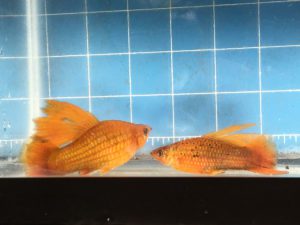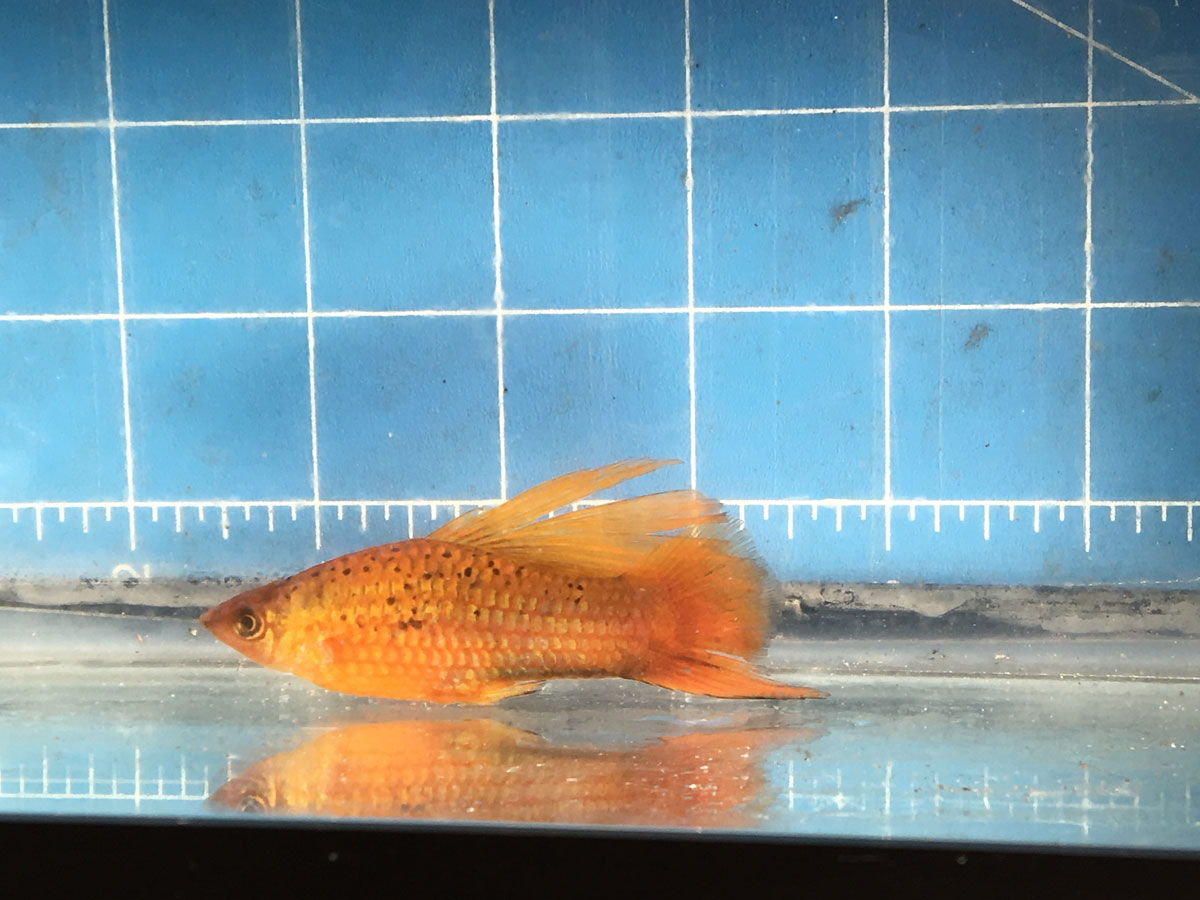Photo: A first generation Red Freckled Hifin Swordtail male in front of one inch grid to show size.
Okay, it’s going to take a while to untangle the genealogy of this fish. Let’s take the female first.

The pictured female is large. She’s in front of a one-inch grid that shows she almost four inches long. This female and her siblings (they are almost identical to her) were the result of a mating of a Red Swordtails and Sunset Hifin Variatus. In turn, the Sunset Hifin Variatus resulted from mating Sunset Variatus to Freckled Hifin Variatus (see http://goliadfarms.com/freckle-hifin-genetic-tests/), which we’d acquired many years ago from a Florida fish farm. The Sunset Variatus were descended from our Redtail Black Variatus (see: http://goliadfarms.com/sunset-variatus/). Our Redtail Black Variatus were developed from some Tuxedo Variatus we got in 2003 from another Florida fish farm (see: http://goliadfarms.com/redtail-black-variatus/).
To recap:
- We selected fish from some nondescript Tuxedo Variatus to develop our strain of Redtail Black Variatus. The black body color is the result of the dominant tuxedo gene combined with modifier genes that increased the black from a “tuxedo” to a black body
- From the Redtail Black Variatus we isolated a few fish that didn’t have the tuxedo gene. The tuxedo gene (technically allele) is dominant so some of our fish must have carried the recessive non-tuxedo gene. The descendants of these non-tuxedo fish became our line of Sunset Variatus.
- We then mated Freckled Hifin Variatus to Sunset Variatus to yield a Sunset Hifin Variatus. It took a couple of generations to regain the sunset color pattern after this cross.
- Finally, to yield the pictured female, we mated Sunset Hifin Variatus to Red Swordtails.
As often happens when crossing various species in the Xiphophorus genus, these are large fish. The grid behind her has one inch squares. Also, swordtail platy hybrids tend to have body shapes intermediate between the parental fish and this female is no different.
Now for the pictured male; he is the offspring of the pictured female or one of her siblings and a Blushing Swordtail/Xiphophorus alvarezi hybrid. This hybrid was accidental. I misread a note and placed a male X. alvarezi in a vat with some Blushing Swordtails. His offspring were orange-red with black freckles. I liked them and am currently working on a separate line of red freckled swordtails from that mating. By the way, these fish are huge, perfectly shaped swordtails.
The pictured male shows these freckles. As is typical of swordtail platy hybrids, the male has a short sword. It’ll take a couple of generations of selection for longer swords to achieve swords like those of X. alvarezi and X. hellerii. The photo below shows him with his mother or aunt.

Where am I going with this line? I set up a breeding colony of the pictured female, three of her siblings, twelve female siblings of the male, and the pictured male and two of his siblings. I hope to produce a line of very large red hifin swordtails with black freckles. To do this, I’ll select future offspring with red bodies and freckled with black. I’ll also pick fish with a more swordtail shape as well as longer swords on the males. It’ll take some selection to convert the orange-red coloration to a true red. Oh, I’ll also use only hifin fish as breeders. To simultaneously select for multiple characteristics requires raising a lot of offspring in hopes of getting everything you want in a single fish.
This process demonstrates four themes in many of my writings about fish breeding. The first was hybridization to combine characteristics from two different fish into one; the second, selection to set a combination of characteristics; third, serendipity; and fourth, raising large numbers of offspring. Hybridization added hifin to sunset coloration; added black freckles to a red body; and added a swordtail. Selection created a sunset color from a redtail black fish. Serendipity in the form of putting a fish in the wrong vat led to the creation of the hybrid sword with a red body freckled with black spots. Raising large numbers of offspring increased my odds of getting the combination of genes I wanted.
Good fishkeeping!


Archie Buchman says
Do you ever see the black sailfin mollies that had a red strip along the dorsal?
charles says
Archie,
Yes. Many of our males sport the orange stripe. I usually try to pick breeder males with the stripe.
Charles
Gaurav Mahajan says
Are these and the Giant Blue Parrots still being developed? Really interesting how hybrid vigor could create such large variatus. Does this freckled line still produce true-breeding hifins?
charles says
We are still working on Red Freckled Swords and Giant Redtail Blue Variatus, but we were hit hard by Hurricane Harvey. We’re in the process of re-inventorying our vats to see what our losses were. I do know we lost one vat of Giant Redtail Blue Variatus. I’m not sure about the other.
Yes, the Freckled Hifins are true-breeding.